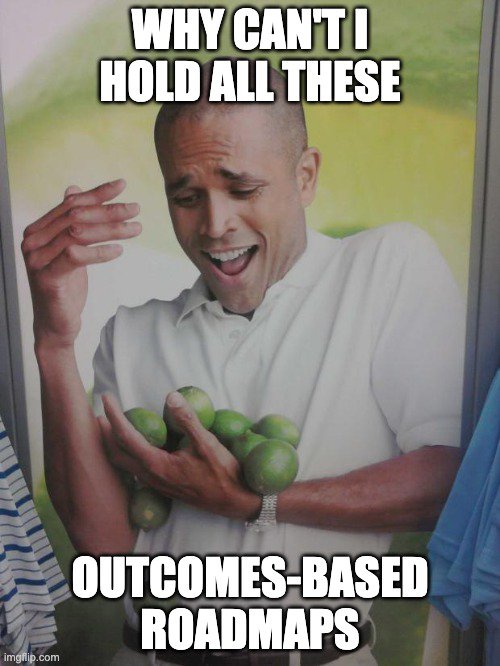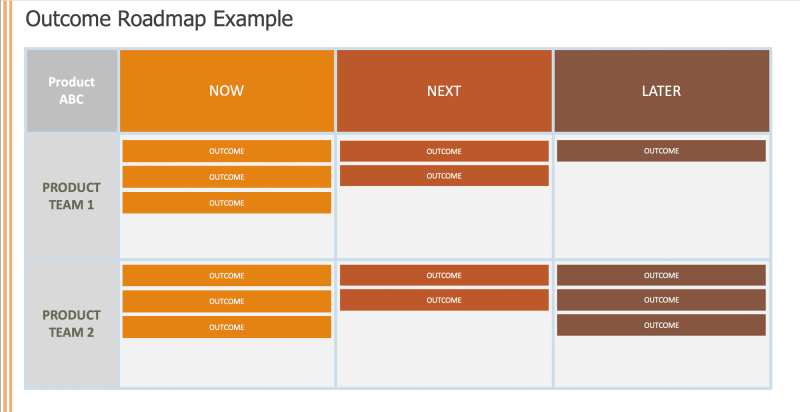I happen to think that Fermi estimation problems are almost as pointless in product management interviews as take-home exercises or case studies (which is an article in itself, but that’s for another day).
That said, a fantastically tongue-in-cheek problem might be, “estimate the amount of articles written about outcome-driven roadmaps since 2019.”
With all of the virtual ink spilled about outcome-driven roadmaps (often called outcome based roadmaps as well) it should be a fairly simple answer as to whether you should adopt it for your product team or organization.
Fortunately, the easy answer is yes, you should adopt an outcome-driven roadmap model.
Article over!
Since we’ve already answered the question in the title, we’re done here, right?
Not quite.

Because we are all product managers, we have to keep asking questions.
To me, the relevant questions with regard to outcome-based roadmaps are:
Does my strategy align with my vision?
Do my outcomes align with my strategy?
Are my tactics aligned with my outcomes?
Do my KPI’s makes sense for my tactics?
How do I communicate all of this to the rest of my stakeholders?
Can I measure all of this?
There are two ways I like to go about deciding on the specific outcomes I want to prioritize in my outcome-driven roadmap.
Not surprisingly, they depend on which of the above questions I can answer right now with data I have on hand or with a bet I am willing to make. To grossly over-simplify things, I will break them into two buckets.
But wait! What is an outcome-based roadmap?
Many great articles have been written about outcome-driven roadmaps, including articles on why they’re good and why most fail.
If I had to pick a single word as to what an outcome-driven roadmap or outcome based roadmap is, I would choose the word “context.”

At its heart, a good outcome-driven roadmap provides both the why to the release plan’s what, AND the how to the strategy’s why.
It should give the reader, at a glance, the macro initiatives being worked on by the product team that will drive the strategy and vision forward, while also explaining why certain tactics have been chosen.
It shouldn’t force the reader to do the mental roll-up from Feature > Tactic > Outcome, nor should it task the reader to do a KPI evaluation.

The image above features a simple, no-frills approach to an outcome-driven roadmap, and as a bonus shows the power of the Now-Next-Later roadmapping technique.
Notice how there are no dates, no features, no sprints - really nothing but pure outcomes?
That’s the essence of the outcome-driven roadmap.
It pulls readers out of the weeds and gives them a high level view of what your product team is trying to accomplish.
A good outcome is, to quote Jason Doherty, a “change in customer behavior.”
To reiterate my earlier point: if you want to demonstrate what will drive changes in customer behavior, show your release plan, or a features-based roadmap. If you want to demonstrate why those customer behaviors need to change, show an outcome-driven roadmap.
Read our range of product management case studies from airfocus users.
About those two buckets...
This is even more painful than it looks.
Right. The buckets. I like to think about outcomes from both a top down and bottom up point of view depending on what I know, what I think I know, what my stakeholders know, what I can assume, and what I can find out.
The buckets aren’t mutually exclusive, and you can craft outcomes using both approaches in a single roadmap.

At this point, let’s revisit my (relevant) earlier bullets:
Does my strategy align with my vision?
Do my outcomes aligned with my strategy?
Are my tactics aligned with my outcomes?
Do my KPI’s make sense for my tactics?
How do I communicate all of this to the rest of my stakeholders?
Can I measure all of this?
In order for either approach to work, you, your team, your stakeholders, your executives, and pretty much anyone else in your audience need to be crystal clear on what the vision is for your product, and the strategy you’re using to achieve that vision.
If there is any confusion or lack of clarity, the outcome-driven roadmap won’t make any sense, as there will be no context for the context.
Furthermore, the vision and strategy need to be aligned 100% to craft both top down and bottom up outcomes.
As the product manager, it’s your responsibility to know if your strategies and vision align.
So about those buckets again?
Using the top down approach, you can then derive a set of outcomes that will drive that strategy forward, which in turn will help achieve the vision.
Simultaneously, those outcomes will, by necessity, help achieve your KPIs.
From the bottom up, you simply start with KPIs.
If your KPIs and tactics are aligned, then you can create an outcome to achieve them, which will drive the strategy forward, and help achieve the vision.
Generally, if you’re going top down, from Vision > Strategy > Outcome, strategy will answer “How?” for Vision, and outcome will answer “How?” for strategy.
If you’re going bottom up, from KPI > Tactic > Outcome, tactic will answer “What?” to drive the KPI, and outcomes will answer “Why?” for everything else.
Top down approach
Imagine if your vision is to bring the joy of watching films to everyone. Rather noble! Going top down, how will we do that?
Strategy: Recommend movies for our users to watch that will reinforce and increase their love of films.
How can we make accurate recommendations?
Outcome 1: Increase the amount of users who rate films to build customer segments.
Outcome 2: Increase the amount of data points we track per film to build a good algorithm.
Outcome 3: Increase the amount of movies users watch to track genre/style.
Those outcomes are measurable and describe how we can make accurate recommendations.
Bottom up approach
If we’re going bottom up, imagine you have a “movies watched per month” KPI, with a target of 6. What do we need to do to get users to watch more movies?
Tactic 1: Give users a way to tell us what movies they like.
Tactic 2: Make sure we have enough movies for users to watch that fit their profiles.
Tactic 3: Make sure busy users can pick a movie they are likely to enjoy without sifting through our whole library.
Why do we need to do these 3 things?
Outcome 1: Increase the amount of users who rate films to build customer segments.
Outcome 2: Increase the amount of data points we track per film to build a good algorithm.
Outcome 3: Increase the amount of movies users watch to track genre/style.
Why do we need to achieve those 3 outcomes?
Strategy: Recommend movies for our users to watch that will reinforce and increase their love of films.

Hopefully you’re already using outcomes to connect with your stakeholders via your roadmaps. And if you are, I hope you can take some of the tactics here and put them to good use as you build your next iteration.
After all, that was the outcome I was going for here.

Adam Hecht

Read also
Build great roadmaps





